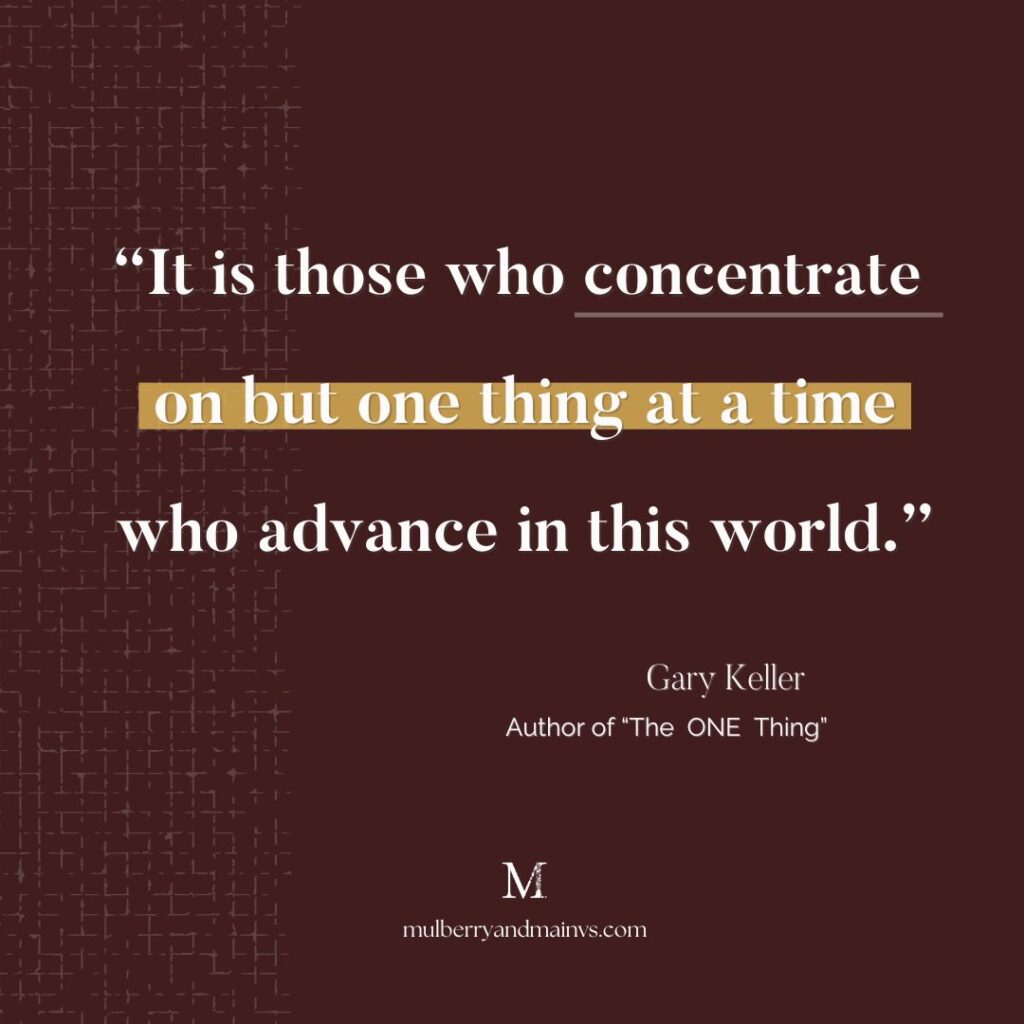The to-do list of a business owner is endless. While we have limited time in our day —yes, even Beyonce has only 24 hours. We can make the most of it with these 6 easy to take control of your calendar.
We wish we could say that 100% of our time is well spent with a high ROI. The reality for most is that it simply is not true.
Most CEO’s that multitask to manage their overflowing schedules can waste up to 40% of their productivity switching between tasks.
As the key decision maker in your business, it’s important to be strategic with your time to get the best return on investment.
Every new phase in business requires new strategies and calendar management is no exception. The schedule that took you to your first 100K may not serve you as you scale to mid-six or seven-figures.
Shifting tasks—and mindsets—doesn’t happen overnight. It’s made with intentional incremental changes. Changing from a burnt-out leader who is a bottle neck to a productive & profitable one, leading a focused team.
Here are 6 things to consider when organizing your schedule as a CEO scaling your consulting businesses.

6 ways to take control of your calendar as a CEO
1. Control Your calendar by Gathering Data First
As a data specialist, seeing this at the top of my list shouldn’t be surprising. Although feelings are powerful for setting intentions, they can mislead our business choices.
Facts vs. Feelings
Emotions are valid, but data is your BFF when it comes to making smart moves.
Have you have ever binged watched anything on Netflix—ahem, Bridgerton? Then you know how “quickly” 4 hours can fly by. Or have you’ve ever been stuck on a sales call gone sideways? You know that 20 minutes can feel like a marathon.
We are human and TERRIBLE at estimating time.
While we may think to ourselves…
😒 “I FEEL like that sales call went awful”
😒 “I FEEL like no one was connecting to my pitch on the webinar”
😒 “I FEEL like I’m always in meetings and never have time to complete tasks”
A quick look at the data may show that what drains your energy is one long call each week. Or having to spread out call each day which forces you to constantly switch focus.
Or that the webinar actually converted at the same or higher rate than your previous one. That lead you thought was lost just signed the contract at 3am because she too has an overcommitted schedule 🤦♀️.
Time Study
I challenge you (and that tired lead at 3 am) to get data every 6 months with a time study.
Track your time in 15 or 30 minute increments to truly understand where your time is going. Create a strategic schedule that serves both your personal and professional goals. Items 2-6 on this list are designed to help you do just that.
Not sure how to conduct a time study?
You can snag a copy of my CEO Time-Audit Template. It will help you isolate the areas of your schedule that may need improvement after reviewing the mini-dashboard.
2. Control Your Calendar by Setting Healthy Boundaries
A sure way to prevent distractions and “busy work” from your calendar is to set healthy values-based boundaries. Having value-based healthy boundaries will filter out any sneaky unaligned tasks.
Lead with Values
Put your values and vision into action for your team and clients to see. Show them it’s more than just words on your website.
👉 Do you value responsiveness?
Add buffer time after calls to send follow up action items in a timely manner
👉 Do you value keeping your word?
Start & end meetings on time
👉 Do you envision more traveling or personal time?
Limit your working windows or move towards a 4 day work week
👉 Do you value delivering quality work to your clients?
Block off the hours you work best for deep work
👉 Do you value strong relationships?
Block off your high energy times for sales and connection calls
Set Your Limits
Knowing your limits is crucial.
Whether you aim for 20 hours or 40 hours, there will always be busy work to fill the gaps. If you don’t set healthy boundaries your calendar will constantly feel overwhelming.
Allowing your vision and values to align your schedule takes the pressure off. You can say “no” with integrity & confidence rather than guilt & hesitance.
Remember, saying “no” is sometimes the most strategic move you can make.
3. Control Your Calendar by Focusing on High-Impact Areas
No one wants to feel like a hamster spinning their wheels. Unfortunately, it’s all too common for business owners to spend a large amount of energy just to go in circles. Only to end up back where they started.
Pareto Principle
Don’t fret, our good friend Pareto principle knows that 20% of our actions generate 80% of our results. As mentioned in an article from Hubspot, this may sound discouraging but is quite the opposite.
You are able to do LESS and accomplish MORE! HOORAY!!
When you focus on the areas that make the biggest impact it becomes very easy to prioritize tasks. Try structuring your days around a few key tasks rather than a marathon list of to-do’s.
High-impact activities might include revenue-generating tasks or strategic planning sessions.
Focus on What You Can Control
There is a myth among business owners that “if I just do exceptional work my business will grow.”
Even with an eye catching portfolio or prestigious list of past clients, at any point referrals can stop. . . crickets.
Referrals are NOT in your control and are only one part of an overall sales strategy.
For true sustainable growth we need to do what is counterintuitive. Prioritize your own business development FIRST rather than solely focusing on your clients success.
Knowing what actions to take and levers to pull to ensure you stay in the driver’s seat. Navigating your business with ease, enjoying a full pipeline & satisfied clients.
Keep your schedule simple and productive, avoiding the trap of busyness. Too many distractions will cause the most veteran CEO to veer off course & crash.
“It is those who concentrate on but one thing at a time who advance in this world. – Gary Keller Author of “The ONE THING”
When you’re clear on your vision and goals, it’s easier to allocate your time where it truly counts.

4. Control Your Calendar by Delegating Effectively
As creative CEOs, we love to do things our way. Sometimes you’ve got to channel your inner “Parks and Recreation” Leslie Knope and delegate.
Unlearn Bad Habits
Don’t get stuck in the mindset that you have to do it all.
While you may complete tasks out of your wheelhouse, it’s not the only way to complete the task.
Arguably, delegating to a team member who’s tasks are aligned with their strengths and expertise will yield far better results.
Learn to think creatively about task management and stay flexible by building a team of strategic thinkers, not just task-takers.
While task-takers will follow a process to the “T”, their goal is simply to complete the task.
A true strategic team member will look for improvements, efficiencies. They seek to better understand how each task helps to achieve the overall business goals.
Attracting quality team members requires a team culture where they can thrive. Focus on creating a team atmosphere that awards accountability, autonomy, and data-driven action.
Focus on Relationships
What separates great CEO’s from the mediocre is not just the willingness to delegate. They are willing to build relationships that allow them to delegate clearly & effectively.
A traditional SOP may not be the best way to share information with your team. Consider other methods that share your vision, passion, ideal outcomes, connections to your goal, and concerns.
You may need to try several tactics before finding what works best for you & your team:
- SOP
- Video instructions
- Visual Examples & References
- Inspiration or Mood Board
- Voice Messages
- Team Challenges
- Team co-working Sessions
Effective delegation frees you up to focus on what you do best. The sooner you master this skill the easier it will be to scale your audience, impact, and profit.
5. Prevent Burnout by Prioritizing Self-Care
Burnout is often written about and often misconstrued. The Oxford dictionary defines burn out as “the reduction of a fuel or substance to nothing through use or combustion.”
Know What Fills You Up
Essentially you and your business are a complex machine that needs fuel to fly. If you ignore the warning signs for too long a crash is inevitable.
To keep your creative energy flowing, make time for activities that fill you up.
This doesn’t mean it has to take up lots of your time. Rather, the time spent needs to be quality activities that you connect with personally.
What fuels you may not fuel your team or others.
Schedule Routine Self-Care
Think of the last time you put gas in your car? How long did it take you? 5 minutes, maybe 10 if you went inside and grabbed a diet coke and a snack? And did you question what gas to use?
Of course not! You didn’t hesitate. It was easy to recognize the signs and did what needed to be done to get back on the road quickly.
You should share this same level of awareness in your business as you do with your car.
Stop taking better care of your car than you do yourself!
Create an Action Plan
Take 5 minutes to answer the following questions to address the symptoms of burnout well before a breakdown.
- What are my personal “low fuel” signs?
- Common signs are low energy, irritability, disengagement or distancing from work, increased negativity or cynicism, making more mistakes, and or feelings of high anxiety or apathy.
- What fuel do I & my business require?
- Reading, walking, meditating, practicing a hobby or craft, listening to music, journaling, praying, reconnecting with friends, learning something new, or accomplish something on your bucket list.
- When is the best time to add this to my schedule?
- Create a list of what can be done in 30 min or 1 hour vs what needs to be planned in advance. Every quarter try to plan 1 bigger item on the list and keep it handy to add in shorter activities as needed.
Lastly, work with your team to schedule some of your fuel activities during or after busy weeks. Especially weeks with events such as launches, workshops, speaking engagements, excessive travel, etc.
Waiting until your fuel is low puts your business and team at risk of crashing with you. Be sure to look out for the warning signs and check in regularly with yourself and team. Acknowledge and symptoms consistently replenish your energy, creativity, and motivation.
6. Leave intentional white space to stay flexible
A perfectly organized and filled calendar may seem like an achievement but life doesn’t always go according to plan. You have to factor in the unexpected.
Factor in the Unexpected
You have to factor in the unexpected. What would happen if you had to squeeze in a last minute doctors appointment or had unexpected flat tire? Would your schedule for the rest of the day starts to topple like dominos?
A rigid calendar limits how you can respond to unwanted emergencies. It also doesn’t allow for the positive unexpected events or opportunities. This can lead to missed chances, lost revenue, and increased stress.
Instead, we need to avoid tightly stacking our schedules like Tetris. Think of your schedule as an outfit. The aim is to not be overdressed nor underdressed. You want to be able to move freely, without feeling stuffy or exposed & vulnerable.
According to a study by McKinsey, businesses that embrace flexible scheduling can see a productivity increase of up to 30%.
Don’t Fill In the Gaps
Creating white space allows you & your schedule to breath. Finding the right balance can be tricky. With practice you learn to accessorize as needed and event adjust to the seasons.
You’ll be able to group tasks to compliment your personality and working styles. Try incorporating tactics like the 4 day work week, time blocking, Pomodoro method, and themed days.
The American Institute of Stress reports that 80% of workers feel stress on the job. Many citing lack of flexibility as a significant contributor .
Building buffer times into your schedule is essential. Adding this step into your weekly routine to ensures you can adapt quickly. Staying on top priorities without feeling overwhelmed.
In Conclusion:
By embracing these top 6 strategies, you’ll be well on your way to building a sustainable schedule. Enjoy thriving both professionally and personally.
Continue to use your data to drive decisions. Set healthy boundaries, focus on high-impact areas, delegate effectively, and prioritize self-care to avoid burnout. Your vision board moments aren’t just dreams – they are achievable realities.
Next Steps:
What strategies do you use to keep your business sustainable? Share your experiences in the comments! If you need a helping hand in implementing these practices, let’s connect.
I’m here to help you create a business and life you love. 🚀✨





